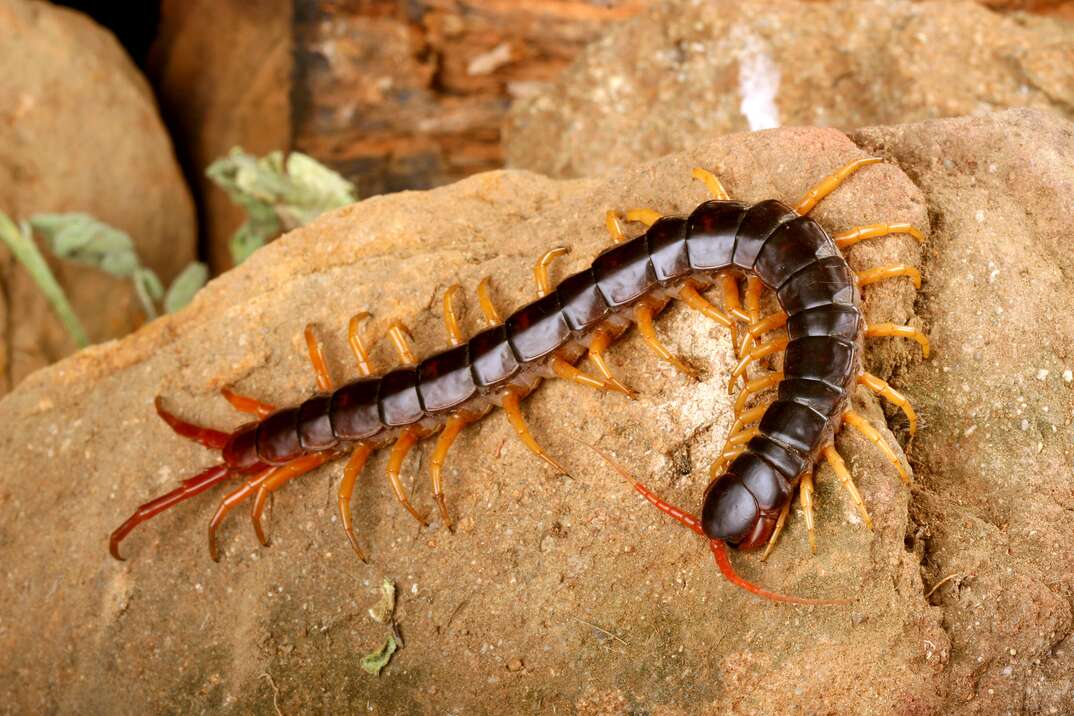Centipede Extermination: Treatment Options With Legs

If the sight of a scuttling centipede turns your stomach, you're not alone. While these creepy crawlies aren't the worst creatures to have inside your home, you probably don't want to see them scurrying around your living space.
Read More Home Improvement Articles
Fortunately, centipede extermination is relatively straightforward with the right knowledge. Here’s what you should know.
What Do Centipedes Look Like?
Centipedes are a type of arthropod. They have long, flat bodies split into segments, and each segment has a pair of legs. Although the word centipede means "100 feet," they can have between 15 and 177 pairs of legs.
Despite their poor eyesight, centipedes are skilled hunters. These carnivorous critters have long antennae to help them locate their prey and adapted front legs with venomous claws. Centipedes come in various colors, but most common species in the United States are brown and orange.
At first glance, centipedes and millipedes are highly similar. Both have distinctive, segmented bodies with multiple pairs of legs, although millipedes have two pairs of legs on each segment. Unlike centipedes, millipedes are herbivores and have short antennae. They feed by burrowing through the soil, eating leaves, fungi and dead plants.
Do Centipedes Bite?
Centipedes don't generally bite humans, but they can deliver a painful sting with their venomous claws and will defend themselves when they feel threatened. You could get stung if you disturb a centipede while working in your yard or if you have centipedes in your home.
Although centipede stings can be sore, they aren't usually dangerous. Some people report symptoms, such as vomiting, headaches and swelling, but they typically subside within a few hours. Occasionally, centipede stings can cause anaphylactic shock in people with allergies.
How Do You Know You Have a Centipede Problem in Your Home?
It's common to see the occasional centipede inside your home, but seeing several could be a sign of a bigger problem. The presence of other pests in your home can also signify that a centipede infestation is around the corner because centipedes feed on bugs, such as silverfish, ants and bedbugs. Another infestation makes it more likely that centipedes will come inside your home to find food.
If you're unsure whether you have a centipede infestation, you can try inspecting your home using a flashlight. It's best to look at night when centipedes are most active, and you're more likely to see them during warmer weather. Focus on damp areas, such as bathrooms and kitchens, as centipedes prefer moist environments.
More Related Articles:
- What to Look For When Hiring an Exterminator
- Are Pest Control Products Dangerous For Kids and Pets?
- What Are Ultrasonic Pest Repellers?
- 10 Ways to Prevent Termites
- How to Spray for Mosquitoes
What Are Some Options for Getting Rid of Centipedes?
There are several centipede extermination options, and which one you should use depends on the extent of the problem. Effective methods include:
Trapping
If you only have a few centipedes in your home, trapping them and relocating them outside whenever you see them can help reduce the risk of a bigger infestation. You can trap a centipede by covering it with a glass and sliding a piece of cardboard underneath.
Don't attempt to pick up a centipede with your bare hands, as it could feel threatened and sting you. It's best to release a captured centipede as far away from your home's perimeter as possible to stop your house guest from making its way back indoors.
Sticky Traps
Sticky traps catch centipedes when their feet stick to the strip, preventing them from escaping. You can purchase sticky traps online and from most DIY stores. Place the traps around your home, prioritizing dark, damp areas.
An advantage of using sticky traps is that they also catch other pests. Knowing what other pests are in your home can be helpful, as centipedes are often a warning sign of another infestation.
Sprays
If you don't mind using such products in your home, centipede extermination sprays and dusts can be an effective solution. Many products claim to eradicate a wide range of pests, but it's usually wise to pick a formula designed to kill centipedes for the best results. These chemicals can be hazardous to humans and animals, so they may not be a good choice if you have small children or pets.
Professional Centipede Extermination
If you have a significant infestation or DIY methods don't work, you could consider calling a centipede extermination company. A professional can select the most effective extermination method and inspect your home to identify and treat the source of the problem. Expect to pay around $400 per visit for centipede extermination services.
How Do You Prevent Centipedes From Entering Your Home?
Centipedes enter your home through tiny cracks in your home's exterior. Therefore, sealing any gaps in walls, weatherstripping and floors is an effective way to keep them out. As other pests can encourage centipedes to come inside, it's also essential to treat infestations as soon as you notice them.
Elocal Editorial Content is for educational and entertainment purposes only. Editorial Content should not be used as a substitute for advice from a licensed professional in your state reviewing your issue. Systems, equipment, issues and circumstances vary. Follow the manufacturer's safety precautions. The opinions, beliefs and viewpoints expressed by the eLocal Editorial Team and other third-party content providers do not necessarily reflect the opinions, beliefs and viewpoints of eLocal or its affiliate companies. Use of the Blog is subject to the
Website Terms and Conditions.The eLocal Editorial Team operates independently of eLocal USA's marketing and sales decisions.



